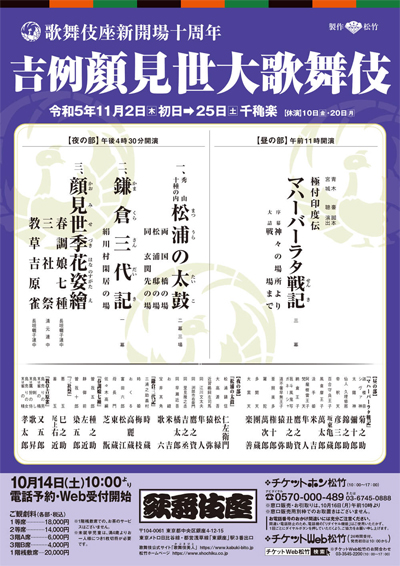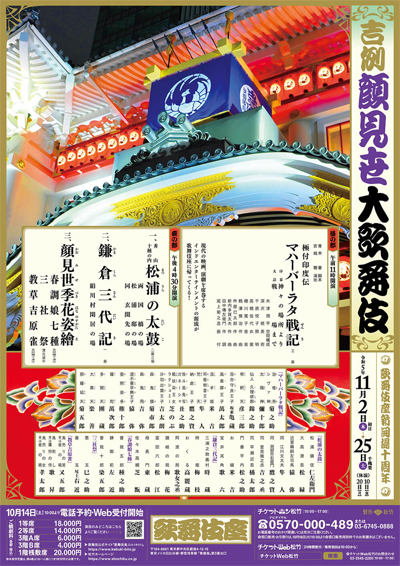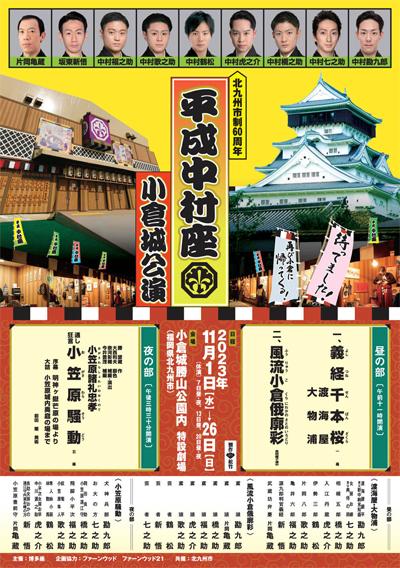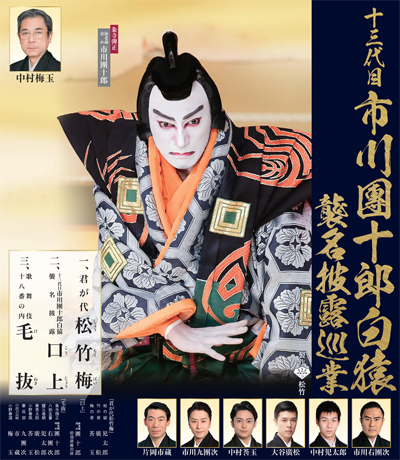| Casting |
Living National Treasure Onoe Kikugor˘, Living National Treasure Kataoka Nizaemon, Living National Treasure Nakamura T˘z˘, Living National Treasure Nakamura Karoku, Onoe Kikunosuke, Nakamura Shikan, Kataoka Takatar˘, Onoe Sh˘roku, Nakamura Kinnosuke, Ichikawa Danz˘, Band˘ Yajűr˘, Band˘ Rakuzen, Nakamura Matagor˘, Band˘ Hikosabur˘, Ichikawa Komaz˘, Ichikawa En'ya, Band˘ Kamez˘, Nakamura Hayato, Band˘ Minosuke,
Onoe Ukon, Nakamura Baishi, Nakamura Yonekichi, Nakamura Kash˘, Nakamura Mantar˘, Kamimura Kichiya, Kawarasaki Gonjűr˘, Nakamura Matsue, Nakamura Takanosuke, Nakamura Tanenosuke, Ichikawa Somegor˘, Onoe Sakon, Onoe Ushinosuke, Ichimura Kitsutar˘, Nakamura Kichinoj˘, Nakamura Shinobu, Kamimura Kichitar˘, Nakamura Kamenoj˘, Kataoka Matsunosuke, Nakamura Baika
|
| Comments |
The usual November Festive Face-Showing Grand Kabuki!
MahÔbÔrata Senki: This is Kabuki production adapted from one of the world's three greatest epics, the rest two being "Iliad" and "Odyssey" of ancient Greece.
"MahÔbhÔrata" is a mythical epic of ancient India and
one of the two greatest epics of India with "Ramayana". It was premiered in October 2017 at the Kabukiza.
Here is the place where gods meet.
Many gods such as Narayana (Living National Treasure Onoe Kikugor˘), Surya (Band˘ Yajűr˘),
MahÔkÔla (Band˘ Rakuzen), Indra (Band˘ Hikosabur˘),
Brahma (Nakamura Hayato) and Shiva (Onoe Kikunosuke) look down on human world.
Shiva is astonished at the absurdness of human beings and laments that. Surya begets a child by very young
Princess Kunti (Nakamura Yonekichi) and tries to make him a savior to reign over the human world peacefully.
But Indra is opposed to Surya. He also begets a child by Princess Kunti and intends to let him rule
the human world by force. Surya's child is Karna (Onoe Kikunosuke) and Indra's child is Arjuna (Nakamura Hayato).
Princess Kunti gives birth to Karna, but she floats him in Ganges. The years flow away and Karna grows
up to be a youth of born abilities. As he bids his parents farewell to travel for practicing archery,
his mother Rana (Ichimura Manjir˘) confides to him that she is not his real mother. Karna comes to the capital
where five princes including Arjuna, who are brought up in a royal family, are in rivalry in throne against
Karna's cousins, Princess Duryodha (Nakamura Shinobu) and her brother. Hermit Krishna (Nakamura Kinnosuke) arbitrates that and they agree to decide
in a tournament who deserves the throne. Karna also takes part in the tournament and confronts Prince Arjuna,
but he is mistreated as his origin is unknown. Noticing that Karna is her son whom she floated in Ganges,
Princess Kunti falls senseless and the tournament is called off. Karna bears a grudge against the five
princes and he goes with Princess Duryodha. More years pass and the rivalry in throne becomes harder.
Prince Arjuna laments vanity that they relatives oppose each other,
but the war begins in Kurukshetra. Karna takes Princess Duryodha's side and confronts the five princes
including his predestined rival, Prince Arjuna.
Matsuura no Taiko: Lord Matsuura (Living National Treasure Kataoka Nizaemon) lives next door to the
enemy of the loyal retainers and is disgusted because they do not seem to be
interested in avenging the death of the lord. He is especially upset because
he studied with the same fighting teacher as Kuranosuke, the senior retainer
who should be leading the vendetta. Moreover, he learns from the haiku teacher
Takarai Kikaku (Living National Treasure Nakamura Karoku) that his student ďtaka Gengo (ACT) who should be part of
the vendetta left a poem suggesting that he was forgetting his former lord and
going to take service with another samurai lord. Gengo's sister Onui (Nakamura Yonekichi)
serves Lord Matsuura and in disgust he is about to dismiss her, when there
is a disturbance from next door. The attack has begun, and in joy, Lord Matsuura
counts out the strokes of the drum, struck in a pattern that is only
known by students of his fighting teacher.
Kamakura Sandaiki: a rare performance of a classical history play from the
Bunraku puppet theatre, which shows a heroic warrior, unbending mother and delicate princess
in romance and intrigue on a grand scale. War has placed the young samurai
Miuranosuke (Nakamura Tokiz˘) and his fiance Princess Toki on enemy sides. She takes
care of his sick mother (Living National Treasure Nakamura T˘z˘) despite being on opposite sides, and Miuranosuke
slips away from the battle to see his mother one last time. But she refuses
to see him when he should be on the battlefield and he must leave, brokenhearted.
Princess Toki's father is the leader of the enemy forces and she is
faced with a terrible challenge. She will only be allowed to be united
with the man she loves if she kills her father. Starring Nakamura Baishi as Princess Toki,
considered to be one of the most difficult princess roles in the Kabuki repertory.
Featuring also Nakamura Shikan in the role of Sasaki Takatsuna.
Musume Nanakusa: in the Edo period, every New Year,
plays appeared about the medieval vendetta carried out by the Soga brothers
Jűr˘ and Gor˘. This colorful, old-fashioned dance mixes this tradition with
that of eating porridge containing seven auspicious herbs on the seventh
day of the new year. As the brothers Jűr˘ (Ichikawa Somegor˘) and Gor˘ (Nakamura Tanenosuke)
prepare to face their father's murderer and take revenge, along with beautiful
Shizuka Gozen (Onoe Sakon), they cut the herbs, as a symbolic act of vengeance.
Sanja Matsuri: a vigorous dance starring Band˘ Minosuke and Onoe Ukon.
It is based on dolls at the Sanja festival
showing the founding of the temple at Asakusa
when two fishermen found a golden image of the Kannon
in their nets. In this case, the holy spirits that they encounter are two spheres
with the characters for "good" and "evil" on them, and the spirits possess
the two and animate them into a lively dance.
Yoshiwara Suzume: in this dance, a husband and wife come to the
Yoshiwara pleasure quarters to sell caged sparrows for
a ceremony to gain Buddhist merit by releasing living things. Caged sparrows were
also images for the courtesans of the pleasure quarters,
and the two dance a romantic meeting between a courtesan and her lover,
showing the lively and erotic atmosphere of the pleasure quarters.
Starring Nakamura Matagor˘, Kataoka Takatar˘ and Nakamura Kash˘ as a male bird seller, a female bird seller and a bird catcher (in reality a samurai practicing falconry).
Sources: Earphone Guide Website or Sh˘chiku Kabuki Official Website
|





